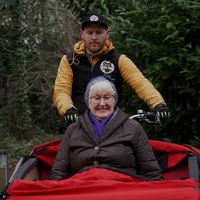What are barriers?
Barriers make access to safe active travel routes unequal.
What are barriers?
A barrier is anything that restricts or prevents a legitimate user from accessing or travelling along the National Cycle Network.
What issues do barriers create?
Barriers make access to safe active travel routes unequal.
They prevent legitimate users from walking, wheeling or cycling along the National Cycle Network.
Barriers disproportionally impact people who use mobility aids or non-standard cycles.
These come in all shapes and sizes, and many are longer or wider than a standard bicycle. This means they may need more space to turn and pass through gaps.
Barriers also affect people who are not able to get off their cycle to manoeuvre through or around them.
Physical barriers on the National Cycle Network are preventing access to many users. In this video, we explore why these barriers need to be redesigned to make the Network truly accessible for everyone.
Types of barriers

A frames and K frames
A frames are access barriers designed to prevent vehicles such as motorcycles and mopeds from accessing footpaths and cycle routes.
However, they are often ineffective at stopping motorbikes from getting onto the routes. And if the opening isn't wide enough, they are impossible to navigate for wider cycles, prams, mobility aids, trailers and anyone who can't dismount.
K frames are similar in design, but include a steel plate on either side of the opening.

Chicanes
Chicanes use barriers to create a turn in the path.
If the gap is wide enough, chicanes may not be a problem.
But if the barriers are close together, lots of people won't have enough space to turn.
If you're unable to dismount, pulling a bike trailer or using a cycle that's longer or wider than a standard bike, a tight chicane might be impossible to get through.
Chicanes can also reduce the capacity of paths. At busy times, this can lead to queues and congestion.

Gates
Gates come in various shapes and sizes.
Kissing gates are common on cycle routes. They use a single swinging gate between two barriers to create a space that one person can pass through at a time.
Gates such as these can be a problem for people who are unable to get off their bike and manoeuvre it through the gap.
They may also be impossible to get through if you're using a wide or long cycle or a mobility aid.

Other barriers
Other common barriers on the Network are:
- Steps and stairs
- Narrow sections of path
- Steep slopes
- Uneven surfaces
- Bollards
Some of these barriers require people to dismount and push their cycles, which not everyone is able to do.
Others may block access to people with non-standard cycles, mobility aids or pushchairs.
Ellis explains how barriers stop him getting around on the National Cycle Network.

Getting a restrictive barrier redesigned: Josh's story
Josh runs a free service which allows people with mobility issues to experience the joys of traffic-free routes through his trishaw rides.
When he encountered a restrictive physical barrier on the National Cycle Network on his trishaw, he was determined to find a solution to make the route accessible for all.


